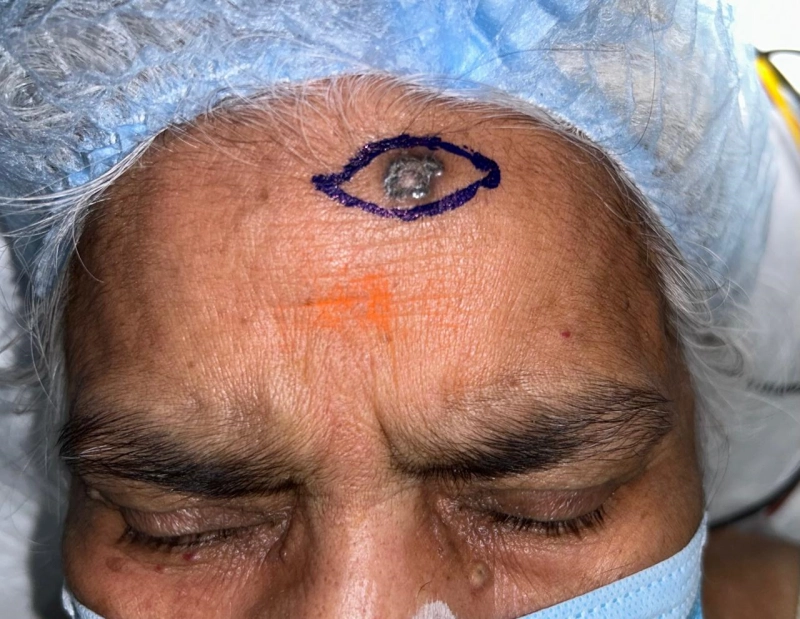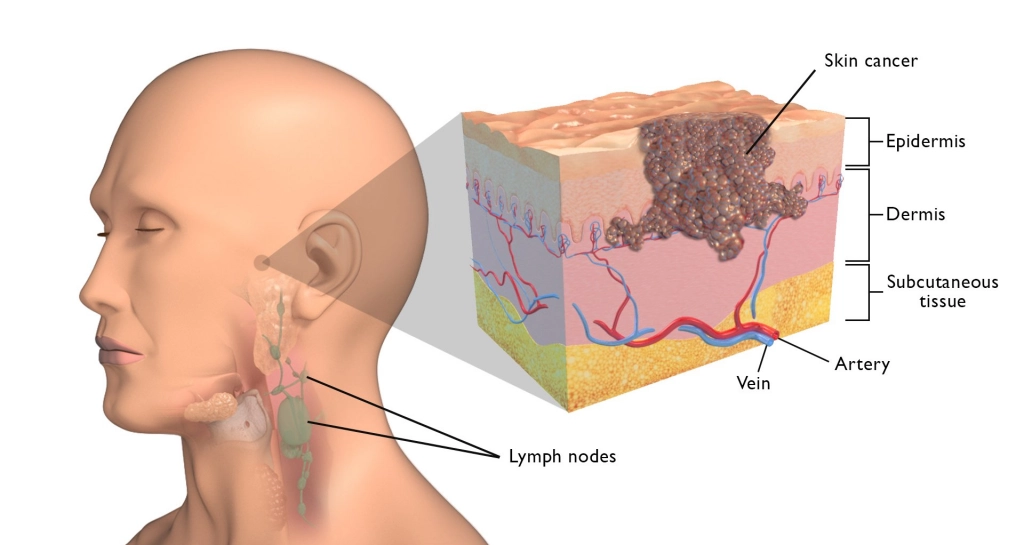What is skin cancer?
A kind of cancer that starts in the skin cells is called skin cancer. With millions of cases reported annually, it is the most prevalent type of cancer in the world. Skin cancer develops when aberrant alterations in normal skin cells cause unchecked proliferation and the development of malignant tumours.
Skin cancer can be of three primary types:
Basal cell carcinoma, or BCC : Is the most prevalent kind of skin cancer, making up over 80% of cases. It typically appears on skin parts like the hands, neck, and face that are frequently exposed to the sun. BCC can cause local tissue damage if treatment is not received, however it usually grows slowly and seldom spreads to other parts of the body.
Squamous Cell Carcinoma (SCC): Representing 20% of cases, squamous cell carcinoma is the second most frequent kind of skin cancer. Additionally, it usually appears on sun-exposed skin areas such as the back of the hands, ears, lips, and cheeks. SCC has a faster rate of growth than the rear of the hands. If treatment is not received, SCC has a greater potential to spread to other areas of the body and can grow more quickly than BCC.
Melanoma: Although less frequent than squamous and basal cell carcinomas, melanoma is more aggressive and has a greater propensity to migrate to other body areas. Melanoma can form anywhere on the body, even in locations that are not exposed to the sun. It starts in the melanocytes, which are the skin’s pigment-producing cells. The appearance of moles or the emergence of new pigmented lesions on the skin are frequently altered in cases of melanoma.
What is skin?
The biggest organ in the human body, skin acts as a barrier to protect internal organs from the outside world. It is made up of several tissue layers that work together to provide protection, feeling, temperature management, and vitamin D synthesis, among other things. The epidermis, dermis, and subcutaneous tissue (hypodermis) are the three main layers of skin. Below is a quick synopsis of every layer:
Epidermis: The epidermis, which is the skin’s outermost layer, shields the body from harmful substances, chemicals, and ultraviolet light. It is mostly made up of epithelial cells known as keratinocytes, which are responsible for producing keratin, a crucial skin structural protein. Melanocytes, which create the pigment melanin that gives skin its colour, are also found in the epidermis.
Dermis: Beneath the epidermis is the dermis, which is the middle layer of skin. It is made up of collagen and elastin-rich connective tissue that gives the skin stability, suppleness, and strength. Blood and lymphatic vessels, nerve endings, sweat glands, and hair follicles are all found in the dermis. It is essential for controlling body temperature, feeling, and the flow of oxygen and nutrients to skin cells.
Hypodermis: The subcutaneous tissue, sometimes referred to as the hypodermis or subcutis, is the layer of skin that lies beneath the dermis and is the deepest part of the skin. It is mostly composed of connective tissue, adipose (fat) tissue, and as well as blood vessels. The subcutaneous tissue protects and cushions the underlying tissues, including the muscles and bones, while acting as an insulating layer to assist control body temperature.
In addition, the skin has other appendages such as sweat glands, sebaceous glands, and hair follicles, all of which are crucial to the preservation of the skin’s structure and function. Furthermore, our skin functions as a sense organ, enabling us to experience pain, pressure, temperature, and touch.
All things considered, the skin is a dynamic, complex organ that is vital to preserving homeostasis and shielding the body from dangers outside. For general well-being and quality of life, its integrity and health are essential.
Causes of skin cancer
- UV radiation exposure: The main cause of skin cancer is UV radiation exposure from the sun or artificial sources like tanning beds. Skin cells’ DNA is harmed by UV light, which can cause mutations that can lead to malignant growth.
- Fair skin: Individuals with fair skin, light-colored eyes, and blond or red hair are more vulnerable to UV damage and skin cancer because they have less melanin pigment in their skin.
- Skinburns and excessive sun exposure: Having a history of severe or blistering sunburns, especially in childhood or adolescence, raise your chance of developing skin cancer in the future.
- Family history: People with a personal or family history of skin cancer are those who have received a skin cancer diagnosis in the past or who have a family history of the condition.
- Weakened immune System: The risk of skin cancer might be raised by immunosuppressive drugs, medical diseases like HIV/AIDS or organ transplantation, or immunosuppressive medications.
- Exposure to specific chemicals: The chance of developing skin cancer may increase if an individual is exposed at work to specific chemicals, such as arsenic, coal tar, or industrial chemicals.


Symptoms of skin cancer
- Skin cancer symptoms include changes to existing moles or skin lesions, such as size, shape, colour, or texture, or the appearance of a new mole that differs from existing ones. These changes are the most common indicator of skin cancer.
- The shape or size of one half of the mole or lesion differs from the other half.
- The lesion’s or mole’s edges are ill-defined, uneven, or scalloped.
- The lesion or mole may have different hues, such as varying tones of black, red, white, blue, or brown.
- Melanomas can range in size from 6 millimetres, which is the size of a pencil eraser, to greater than that.
- A healthcare provider should be seen if a mole or skin lesion changes in size, shape, colour, or elevation, or if new symptoms like itching, bleeding, or ulceration emerge.
Tests for skin cancer
A medical professional will examine the patient’s skin thoroughly, looking for any indications of cancer in moles, freckles, or other skin lesions.
Dermoscopy: Dermoscopy is a non-invasive method that looks closely at skin lesions using a dermatoscope, a specialised device. It aids medical professionals in recognising characteristics that point to skin cancer.
Skin Biopsy: A skin biopsy is the process of taking a sample of tissue from a suspicious lesion or mole on the skin so that a pathologist can examine it under a microscope. This is the most accurate method for identifying the kind and stage of skin cancer.
Imaging Tests: If there is a worry that skin cancer may have spread to surrounding tissues or lymph nodes, imaging tests such as MRI, CT scan, or ultrasound may be utilised to assess the extent of the disease.
Treatment for Skin Cancer
The course of treatment for skin cancer is determined by the patient’s preferences and general health as well as the type, stage, and location of the cancer. Typical therapy choices could consist of:
Surgery: The majority of skin cancer cases are treated primarily by surgical excision of the malignant lesion. To remove the tumour and a margin of healthy tissue, may entail extensive local excision, Mohs micrographic surgery, or excisional biopsy.
Radiation therapy: To destroy cancer cells, high-energy radiation beams are used in radiation therapy. In cases when surgery is not practical, it can be used as the main treatment for skin cancer. It can also be used as adjuvant therapy to lower the chance of recurrence following surgery.
Chemotherapy: Chemotherapy for skin cancers other than melanoma is rarely administered; typically, a needle with a cannula (tube) attached is used to inject the medication into a vein. Chemotherapy targets cancerous cells, which divide quickly.
Immunotherapy: Immunotherapy is a type of systemic treatment that may be advised to people with melanoma. Numerous melanoma patients might also be invited to participate in a research trial including various formulations of these medications.

